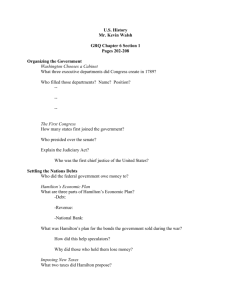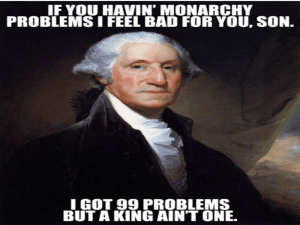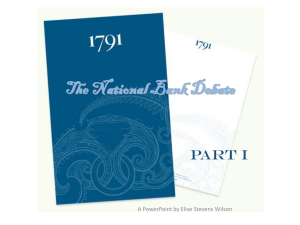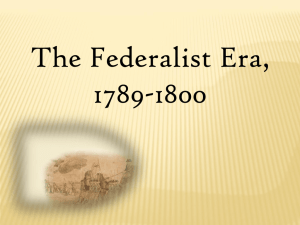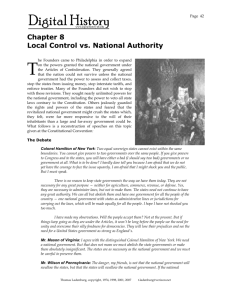Chapter 4 Hamilton, Jefferson, and the First National
advertisement
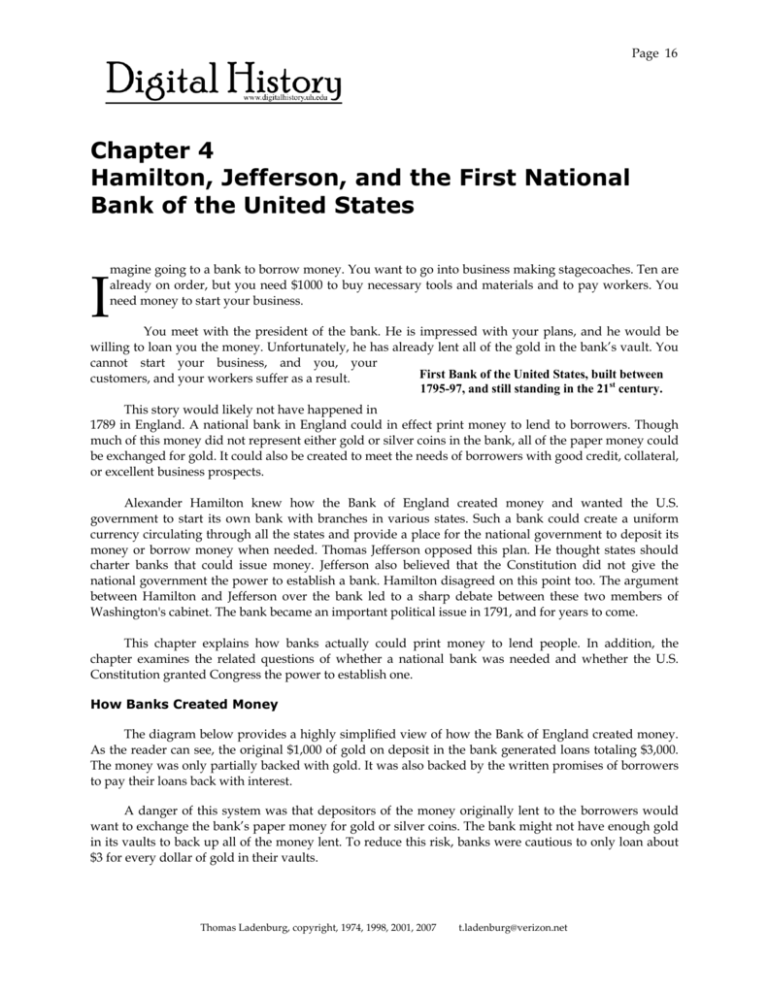
Page 16 Chapter 4 Hamilton, Jefferson, and the First National Bank of the United States I magine going to a bank to borrow money. You want to go into business making stagecoaches. Ten are already on order, but you need $1000 to buy necessary tools and materials and to pay workers. You need money to start your business. You meet with the president of the bank. He is impressed with your plans, and he would be willing to loan you the money. Unfortunately, he has already lent all of the gold in the bank’s vault. You cannot start your business, and you, your First Bank of the United States, built between customers, and your workers suffer as a result. 1795-97, and still standing in the 21st century. This story would likely not have happened in 1789 in England. A national bank in England could in effect print money to lend to borrowers. Though much of this money did not represent either gold or silver coins in the bank, all of the paper money could be exchanged for gold. It could also be created to meet the needs of borrowers with good credit, collateral, or excellent business prospects. Alexander Hamilton knew how the Bank of England created money and wanted the U.S. government to start its own bank with branches in various states. Such a bank could create a uniform currency circulating through all the states and provide a place for the national government to deposit its money or borrow money when needed. Thomas Jefferson opposed this plan. He thought states should charter banks that could issue money. Jefferson also believed that the Constitution did not give the national government the power to establish a bank. Hamilton disagreed on this point too. The argument between Hamilton and Jefferson over the bank led to a sharp debate between these two members of Washington's cabinet. The bank became an important political issue in 1791, and for years to come. This chapter explains how banks actually could print money to lend people. In addition, the chapter examines the related questions of whether a national bank was needed and whether the U.S. Constitution granted Congress the power to establish one. How Banks Created Money The diagram below provides a highly simplified view of how the Bank of England created money. As the reader can see, the original $1,000 of gold on deposit in the bank generated loans totaling $3,000. The money was only partially backed with gold. It was also backed by the written promises of borrowers to pay their loans back with interest. A danger of this system was that depositors of the money originally lent to the borrowers would want to exchange the bank’s paper money for gold or silver coins. The bank might not have enough gold in its vaults to back up all of the money lent. To reduce this risk, banks were cautious to only loan about $3 for every dollar of gold in their vaults. Thomas Ladenburg, copyright, 1974, 1998, 2001, 2007 t.ladenburg@verizon.net Page 17 Bank Gold $1000 IOU signed by borrower 3 promising to repay bank $1000 paid & printed by bank, loaned to borrower 1. $1000 paid & printed by bank, loaned to borrower 2 $1000 signed by borrower 1 promising to repay bank. $1000 signed by borrower 2 promising to repay bank. $1000 paid & printed by bank, loaned to borrower 3. Hamilton Proposes the National Bank Alexander Hamilton was well aware of the ideas on banking explained in these pages. In fact, he was a great admirer of the Bank of England. He paid this bank the greatest possible compliment by proposing to establish a national bank in the United States based on the principles used by its British counterpart. To be more specific, Hamilton drew up a plan to establish a bank that would: ¾ ¾ ¾ ¾ ¾ Have branches in every major city throughout the land. Issue money that would be equally acceptable in all parts of the nation. Help in the creation of new money through borrowing. Loan money to the government when needed. Serve as a place for the government to deposit its money. On December 16, 1790, Alexander Hamilton presented his Report on a National Bank to Congress. In this report, Hamilton made the following specific proposals about his bank: Thomas Ladenburg, copyright, 1974, 1998, 2001, 2007 t.ladenburg@verizon.net Page 18 ¾ The bank’s stock would be worth $10,000,000. ¾ 20,000 shares would be sold privately at $400 per share ¾ Stockholders would pay $100 in gold and silver coin for each share and $300 in government bonds. ¾ 5,000 shares or $2,000,000 of bank stock would be bought by the U.S.government. ¾ The bank would be run by a 25-man board of directors—20 chosen by the shareholders and 5 by the government. ¾ The bank’s president would be elected by the board of directors. ¾ Notes and bills (money) issued by the bank would be redeemable on demand in gold and silver coin and would be accepted by the U.S. government for all payments due. ¾ The bank’s charter would run for 20 years and would be subject to renewal by Congress. ¾ The bank would be allowed to establish branch offices in other cities; its main branch would be in Philadelphia, the nation’s capital. Jefferson’s Objections to the Bank Thomas Jefferson objected strongly to Hamilton’s proposal for a national bank. Among the reasons he and his followers gave for their opposition, the following were the most important: • • • • With its special powers and privileges, the U.S. bank would hinder the development of state banks. The bank would be of far more help to wealthy businessmen in cities than to farmers in the country. The bank would be run by wealthy stockholders and would help this privileged class become more rich and powerful. The Constitution did not give the national government the power to establish a bank. The Debate Over the Bank The argument between Hamilton and Jefferson over the bank finally boiled down to one question: was it constitutional? Jefferson and his supporters lost that argument in Congress, which passed the Bank Bill in February 1791. Their last hope to stop the bank was to convince President Washington not to sign the bill into law. Jefferson sat down to write his argument proving the Constitution did not give Congress the right to establish the bank. He finished on February 15th and hurriedly placed his report on Washington’s desk. Hamilton saw Jefferson’s composition and swiftly penned a reply, which he finished eight days later. Both Jefferson’s and Hamilton’s arguments were based on the Constitution’s Preamble, the “elastic clause” (Article I, Section 8, clause 18), and Amendment X. The elastic clause gave Congress the right to make laws “necessary and proper” to carry out other powers given Congress. Did these words mean that Congress could start such a large institution as a government bank? Jefferson answered no—because Amendment X to the Constitution stated that any powers not specifically given the national government or specifically denied the states were given to the states or the people. But the Preamble to the Constitution stated the purposes for creating a new government, including forming a more perfect union and promoting the general welfare. Wouldn’t chartering a bank fall under these purposes? Thomas Ladenburg, copyright, 1974, 1998, 2001, 2007 t.ladenburg@verizon.net Page 19 Hamilton Favoring a Bank Jefferson in Opposition I consider the foundation of the Constitution that “all powers not delegated to the United States, nor prohibited by it to the States, are reserved to the States, or to the people” (10th Amendment). To take a single step beyond the boundaries that are specifically drawn around the powers of Congress, is to take possession of a boundless The means by which national exigencies (needs) are to field of power, no longer susceptible of any definition. be provided for, national prosperity promoted, are of such infinite variety, extent, and complexity, that there It has been much urged that a bank will give great must of necessity be a great latitude of choice in the convenience in the collection of taxes...yet the selection and application of these means. Hence, the Constitution allows only the means which are not those which are merely necessity of exercising the authorities entrusted to a “necessary,” “convenient”...there is not one (power) which ingenuity government on principle of liberal construction. may torture into convenience, in some instance or other, …If the end (purpose of a law) be clearly comprehended to someone of so long a list of enumerated powers. It within any of the specific powers, and if the measure would swallow up all the delegated powers, and reduce have an obvious relation to the end, and is not forbidden the whole to one power...Therefore it was that the by any particular provision of the Constitution, it may be Constitution restrained them to the necessary means; that safely deemed to come within the compass of the is to say, to those means without which the grant of the national authority. power would be nugatory (useless).17 ...(A) restrictive interpretation of the word “necessary” is also contrary to this sound maxim of construction: namely, that the powers contained in a constitution ought to be construed liberally in advancement of the public good. President Washington read both arguments carefully, and agreed with...? Suggested Student Exercises: 1. Explain in detail how banks can increase the supply of money. 2. What were the particular provisions of Hamilton’s bank bill that were absolutely necessary to the success of the bank, and which provisions seemed to put more power than necessary in the hands of a small, unelected elite? 3. Were Hamilton's arguments for the Bank better than Jefferson's arguments against it? Your answer should be based on: a. the need for a bank—was it necessary under the elastic clause definition of that word, or simply convenient? b. the precedent that would be set if a bank were created—would it provide needed powers to the national government or needlessly weaken the states? 17 Richard Hofstadter, Great Issues in American History (Vintage Books, New York, 1958), pp. 160-69. Thomas Ladenburg, copyright, 1974, 1998, 2001, 2007 t.ladenburg@verizon.net
